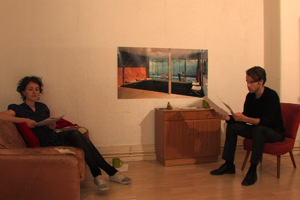
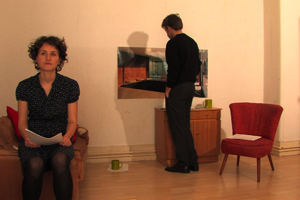 Actors: Valentina Knezevic, Jost von Harlessem
Text, Director, Camera: Ximena Aburto Felis
Actors: Valentina Knezevic, Jost von Harlessem
Text, Director, Camera: Ximena Aburto Felis
This video continues my discussion of the video medium and its loop feature, which is nowadays being taken for granted. In the video two actors are rehearsing a dialogue. The text, which was explicitly developed for this video, is very existentialist, yet the relationship between the two people in the video is kept a secret. The video seems to be in a loop, but in reality it is not. Each time the actors have finished one part of the text, they start anew. Not only does each performance repeat the original act as a quotation, but is further enlarged each time it is reenacted. Everything is repeated exactly and precisely; every word, every motion is like a rehearsed choreography.
The video was made possible thanks to the generous support of the Museum of Modern Art in Frankfurt for the exhibition: "New Frankfurt Internationals".
------------------------------------------------------------------------------------------------ falling asleep 2009, 1-channel-video, colour, sound, 5.40 min. loop
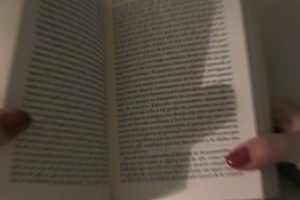
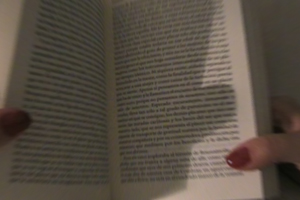 In this video everything is reduced to a minimum. A person lies in bed. The observer
can follow the reading of a page through the little movements of the finger.
With time he will see that the letters become slightly blurred, an intermediate stage,
followed by pictures of falling into a bottomless pit. Finally the video starts at the
beginning again, the situation seems to be as before. Maybe it was all a illusion.
Everyone knows the situation: we start to read in bed and soon we start falling asleep.
By going into another awareness level, the reading is broken off. Between waking and
dreaming the feeling of falling sets in. We wake up suddenly only to realize: we are
in the "safety" of our bed. At the same time there is a connection to Marcel Proust's
"In search of lost time". The book in the video is a Spanish translation of the French
novel. The work brings to mind the famous scene in which the narrator of the novel
describes in a long passage the moment of going to sleep during his childhood. The
work of this video traces on different levels the motives sleep, awareness, memory
and dream.
------------------------------------------------------------------------------------------------
hospital corridor
2009, 1-channel-videoinstallation, colour, sound, ca. 7.30 min. loop function
In this video everything is reduced to a minimum. A person lies in bed. The observer
can follow the reading of a page through the little movements of the finger.
With time he will see that the letters become slightly blurred, an intermediate stage,
followed by pictures of falling into a bottomless pit. Finally the video starts at the
beginning again, the situation seems to be as before. Maybe it was all a illusion.
Everyone knows the situation: we start to read in bed and soon we start falling asleep.
By going into another awareness level, the reading is broken off. Between waking and
dreaming the feeling of falling sets in. We wake up suddenly only to realize: we are
in the "safety" of our bed. At the same time there is a connection to Marcel Proust's
"In search of lost time". The book in the video is a Spanish translation of the French
novel. The work brings to mind the famous scene in which the narrator of the novel
describes in a long passage the moment of going to sleep during his childhood. The
work of this video traces on different levels the motives sleep, awareness, memory
and dream.
------------------------------------------------------------------------------------------------
hospital corridor
2009, 1-channel-videoinstallation, colour, sound, ca. 7.30 min. loop function

 A video is projected on to the ceiling of a small room. A series of identical ceiling lights
flash by disrupted sporadically by equally uniform ceiling markings. The corridor seems
to have no ending. The loop picks up here what is anyway a structural building element
in this sequence: The passage from one ceiling light to another is already a serial
repetition which potentially could go on forever, but because of the loop actually never
stops. The room is endlessly repeated in short intervals, in a monotonous rhythm
through which time commences into an endless loop. These moving pictures are part
of our medial-produced collective memory. However, here the observer can empathize
with the patient's perception and thus becomes the leading actor of the installation.
As opposed to films, this video is not just a perpetual sequence of a few seconds, but
one without any ending. The work plays with uncanniness and victimisation.
Associations of transience and death are invoked and one can identify with one's
own bodily perception.
------------------------------------------------------------------------------------------------
loop
2009, 1-channel video, colour, sound, ca. 10 min. Loop
A video is projected on to the ceiling of a small room. A series of identical ceiling lights
flash by disrupted sporadically by equally uniform ceiling markings. The corridor seems
to have no ending. The loop picks up here what is anyway a structural building element
in this sequence: The passage from one ceiling light to another is already a serial
repetition which potentially could go on forever, but because of the loop actually never
stops. The room is endlessly repeated in short intervals, in a monotonous rhythm
through which time commences into an endless loop. These moving pictures are part
of our medial-produced collective memory. However, here the observer can empathize
with the patient's perception and thus becomes the leading actor of the installation.
As opposed to films, this video is not just a perpetual sequence of a few seconds, but
one without any ending. The work plays with uncanniness and victimisation.
Associations of transience and death are invoked and one can identify with one's
own bodily perception.
------------------------------------------------------------------------------------------------
loop
2009, 1-channel video, colour, sound, ca. 10 min. Loop
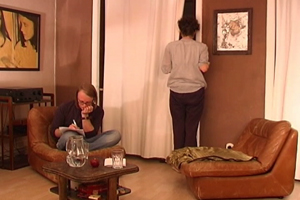
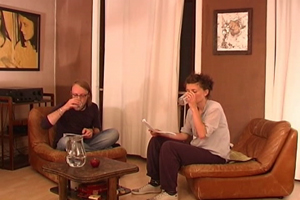 This video focuses on the repetition of the same perpetual movements and the small
change that transcends the re-enactment: Two actors rehearse a theatre play in
which the text revolves around an undefined centre in short monotone sentences.
On perusing the scene, one would assume that this is the first of such meetings. The
as yet unfamiliar text seems alien to them, and so they make mistakes, try out
different intonations. What the observer sees in the scene may seem to be strictly
improvised. In reality, everything is minutely rehearsed: the actors have learnt
all of the motions as in a choreography. The video analyses the loop function which
is nowadays taken for granted. The plot seems to repeat interminable, as so happens
in all exhibitions of today. Only someone who looks more closely will discover that
the action is actually performed anew.
Every new loop not only repeats the preceded action like a quotation, but progresses
each time a little bit more than the previous sequence.The apparent spontaneous
gestures turn out to be repetitive and seem quite artificial all of a sudden. The
observer begins to question his own perception. Did you let yourself be deceived in
the beginning, and was it from the outset only an artificially staged scene, therefore
already a repetition of something, a quotation?
------------------------------------------------------------------------------------------------
amerikanische nacht
2009, one-channel-video, colour, sound, ca 20 min.
This video focuses on the repetition of the same perpetual movements and the small
change that transcends the re-enactment: Two actors rehearse a theatre play in
which the text revolves around an undefined centre in short monotone sentences.
On perusing the scene, one would assume that this is the first of such meetings. The
as yet unfamiliar text seems alien to them, and so they make mistakes, try out
different intonations. What the observer sees in the scene may seem to be strictly
improvised. In reality, everything is minutely rehearsed: the actors have learnt
all of the motions as in a choreography. The video analyses the loop function which
is nowadays taken for granted. The plot seems to repeat interminable, as so happens
in all exhibitions of today. Only someone who looks more closely will discover that
the action is actually performed anew.
Every new loop not only repeats the preceded action like a quotation, but progresses
each time a little bit more than the previous sequence.The apparent spontaneous
gestures turn out to be repetitive and seem quite artificial all of a sudden. The
observer begins to question his own perception. Did you let yourself be deceived in
the beginning, and was it from the outset only an artificially staged scene, therefore
already a repetition of something, a quotation?
------------------------------------------------------------------------------------------------
amerikanische nacht
2009, one-channel-video, colour, sound, ca 20 min.
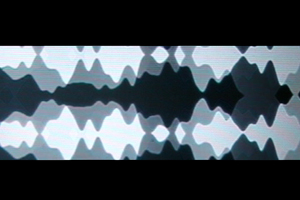 The point of origin for this video establishes the oral form of verbal communication.
Yet this is brought forward on a visual lebel and translated in to a type of pulsating
scripture. What is reached here by the illustration goes beyond the immediate
reasonable dimension of language, as not only the words of the text are registered in
the waves of the recording, but also the actual often more important part of the
communication: the phonetic materiality with which the words are enunciated and a
fundamental dimension of language is expressed.
Separated from the otherwise dominant pictures of the film, the sound part of the
film comes into it's own and in turn unfolds just in the reduction a visual dimension
of innate beauty. One could try to read the waves again and try to reconstruct their
meaning, only to realise perhaps that it is an old film by the French director
François Truffaut.But in this process of repeated broadcasting; inevitably intrinsic
element are lost. As Truffaut already showed in the " American night"
the work reflects the composition of the film medium. It scrutinises the implicitness
of its audiovisual connection and experiments with translation and the involved loss,
yet develops new qualities even in this abstraction.
------------------------------------------------------------------------------------------------
the last hours
2007, three 3-channel-video, colour, sound, ca. 10 Min. in each case.
The point of origin for this video establishes the oral form of verbal communication.
Yet this is brought forward on a visual lebel and translated in to a type of pulsating
scripture. What is reached here by the illustration goes beyond the immediate
reasonable dimension of language, as not only the words of the text are registered in
the waves of the recording, but also the actual often more important part of the
communication: the phonetic materiality with which the words are enunciated and a
fundamental dimension of language is expressed.
Separated from the otherwise dominant pictures of the film, the sound part of the
film comes into it's own and in turn unfolds just in the reduction a visual dimension
of innate beauty. One could try to read the waves again and try to reconstruct their
meaning, only to realise perhaps that it is an old film by the French director
François Truffaut.But in this process of repeated broadcasting; inevitably intrinsic
element are lost. As Truffaut already showed in the " American night"
the work reflects the composition of the film medium. It scrutinises the implicitness
of its audiovisual connection and experiments with translation and the involved loss,
yet develops new qualities even in this abstraction.
------------------------------------------------------------------------------------------------
the last hours
2007, three 3-channel-video, colour, sound, ca. 10 Min. in each case.
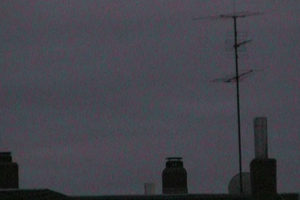
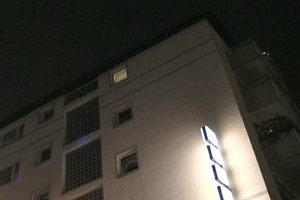 "The last hours" confronts the recipient with three videos in which nothing seems to
happen. In two of them you see a window that, although it seems to be quite late,
is still illuminated. The third shows a view which could be the view you get from one
of the windows. In fast motion day turns into night. With the earphones attached
above the monitors you can engage in the three monologues.
Their intimate thoughts
and experiences circle in sudden crisis around loneliness and the
dark side of man.
The work is a realization of three texts for theatre composed by me.
------------------------------------------------------------------------------------------------
foreigners registration office
2007, one-channel-video, colour, sound, ca. 20 Min.
"The last hours" confronts the recipient with three videos in which nothing seems to
happen. In two of them you see a window that, although it seems to be quite late,
is still illuminated. The third shows a view which could be the view you get from one
of the windows. In fast motion day turns into night. With the earphones attached
above the monitors you can engage in the three monologues.
Their intimate thoughts
and experiences circle in sudden crisis around loneliness and the
dark side of man.
The work is a realization of three texts for theatre composed by me.
------------------------------------------------------------------------------------------------
foreigners registration office
2007, one-channel-video, colour, sound, ca. 20 Min.
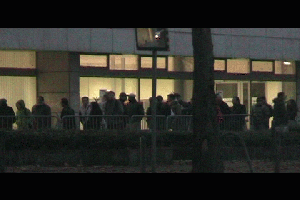 The video shows an unfamiliar everyday situation for most people: On three days of
the week people gather in a line in front of the foreigners registration office in the Gallus,
a district of Frankfurt. Before sunrise and long before the office opens they wait,
hoping for a residence permit. The diffident perspective of the camera does not leave
any room for the here hidden individual fates and hopes. Impassively it documents and
monitors the events, sporadically it provokes reactions yet which remain constrained.
The observation from the inside of a parking car is semi in the open yet stays threateningly
anonymous. The video ends as the people disappear in the brightly lit halls of the office.
Originated as part of the exchange project "The Known and The Foreign" with the Art Academy
of Montevideo.
------------------------------------------------------------------------------------------------
untitled (anaesthesia II)
2007 und 2009 2-channel-video, colour, ca 10 min.
The video shows an unfamiliar everyday situation for most people: On three days of
the week people gather in a line in front of the foreigners registration office in the Gallus,
a district of Frankfurt. Before sunrise and long before the office opens they wait,
hoping for a residence permit. The diffident perspective of the camera does not leave
any room for the here hidden individual fates and hopes. Impassively it documents and
monitors the events, sporadically it provokes reactions yet which remain constrained.
The observation from the inside of a parking car is semi in the open yet stays threateningly
anonymous. The video ends as the people disappear in the brightly lit halls of the office.
Originated as part of the exchange project "The Known and The Foreign" with the Art Academy
of Montevideo.
------------------------------------------------------------------------------------------------
untitled (anaesthesia II)
2007 und 2009 2-channel-video, colour, ca 10 min.
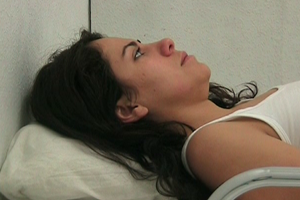
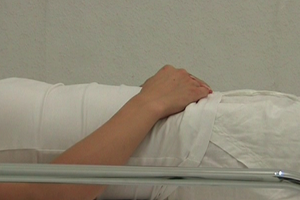 Three monitors focus on each part of the body of a lying woman.
Everything in the picture is white. The minimalistic aesthetic of this work is not only
down to the colour, but also to the event of the video. If the viewer is patient enough,
he will be able to see women in the picture falling asleep. What the viewer cannot know
is, that the woman, i.e. the artist herself, has been given medication to go to sleep.
So this here is not about a natural process of going to sleep, but about a chemically-
induced one. The room, in which the video was taken and eventually is shown, is part
of the installation.
It was built as a walk-in sculpture, in which the observer becomes part of a staged
situation. The impression arises that one has ended up in an eerie room that could be
found in a psychiatric institution of the past.
------------------------------------------------------------------------------------------------
untitled (sleep deprivation)
2006, 2-channel-video, sound, 12 hours.
Three monitors focus on each part of the body of a lying woman.
Everything in the picture is white. The minimalistic aesthetic of this work is not only
down to the colour, but also to the event of the video. If the viewer is patient enough,
he will be able to see women in the picture falling asleep. What the viewer cannot know
is, that the woman, i.e. the artist herself, has been given medication to go to sleep.
So this here is not about a natural process of going to sleep, but about a chemically-
induced one. The room, in which the video was taken and eventually is shown, is part
of the installation.
It was built as a walk-in sculpture, in which the observer becomes part of a staged
situation. The impression arises that one has ended up in an eerie room that could be
found in a psychiatric institution of the past.
------------------------------------------------------------------------------------------------
untitled (sleep deprivation)
2006, 2-channel-video, sound, 12 hours.
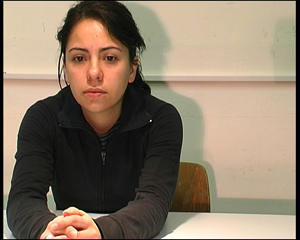
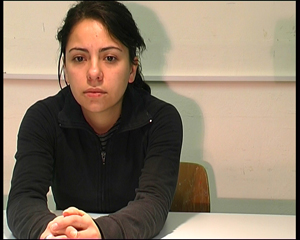 Two monitors transmit the picture of a woman synchronously.
There are two different
cameras, two different perspectives.
The video lasts for 12 hours during which one
sees that the woman (the artist herself) has no room to move. Neither does she drink,
nor does she eat. Every time when sleep seems to overwhelm her,
bright lights are
turned on. Hours later the system does not seem
to work any longer: from then on you see the silhouette of a man
who shakes her to keep her from going to sleep.
This work broaches the issue of sleep deprivation, the most common method of torture.
At the same time it ranges on different levels: experimenting with
your own body
which stems itself against its boundaries.
Self portrait: the body is material,
its meaning is open. A game that plays with the discomfiture of the recipient.
What kind of situation is being dealt with? What is my role in this play?
------------------------------------------------------------------------------------------------
picnolepsy
2005, 3-channel-video, colour, sound, in each case about 5 Min.
Two monitors transmit the picture of a woman synchronously.
There are two different
cameras, two different perspectives.
The video lasts for 12 hours during which one
sees that the woman (the artist herself) has no room to move. Neither does she drink,
nor does she eat. Every time when sleep seems to overwhelm her,
bright lights are
turned on. Hours later the system does not seem
to work any longer: from then on you see the silhouette of a man
who shakes her to keep her from going to sleep.
This work broaches the issue of sleep deprivation, the most common method of torture.
At the same time it ranges on different levels: experimenting with
your own body
which stems itself against its boundaries.
Self portrait: the body is material,
its meaning is open. A game that plays with the discomfiture of the recipient.
What kind of situation is being dealt with? What is my role in this play?
------------------------------------------------------------------------------------------------
picnolepsy
2005, 3-channel-video, colour, sound, in each case about 5 Min.
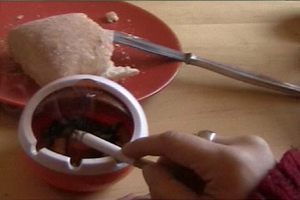
 In this work I deal with the phenomenon of picnolepsy.
Picnolepsy describes the moments of time in which we are not conscious of what is happening around us.
Yet it is not dormancy: we stay awake, but we stop to perceive our surroundings.
These "empty" moments occur during our everyday life,
but we do not register them,
for our memory builds a bridge between the last moment
during which we where
conscious and the next one.
This picnolepsy disappropriates from us moments of our
own experiences. My project adresses these alienated moments of emptiness,
of abysm. The result is a series of three videos.
------------------------------------------------------------------------------------------------
In this work I deal with the phenomenon of picnolepsy.
Picnolepsy describes the moments of time in which we are not conscious of what is happening around us.
Yet it is not dormancy: we stay awake, but we stop to perceive our surroundings.
These "empty" moments occur during our everyday life,
but we do not register them,
for our memory builds a bridge between the last moment
during which we where
conscious and the next one.
This picnolepsy disappropriates from us moments of our
own experiences. My project adresses these alienated moments of emptiness,
of abysm. The result is a series of three videos.
------------------------------------------------------------------------------------------------